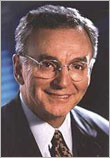|

Remarks

 |
Dr. Joseph Bordogna
Deputy Director
Chief Operating Officer
National Science Foundation
Biography
Remarks, Department of Education Reception for Presidents of Institutions of Higher Education
Indian Treaty Room
Eisenhower Executive Office Building
October 4, 2004
|
We very much appreciate the invitation to say a few words about one of the National Science Foundation's highest priorities -- ensuring the quality of math, science, and engineering education.
The preparation of all children in math and science not only fuels our science and engineering enterprise -- but, in turn, our economy and way of life. Every citizen needs to understand science and mathematics to participate fully in the life of the nation -- to contribute to its prosperity and to enjoy its benefits. As with many people gathered in this room, I was a child of meager means made whole by my teachers. My life, my career, was enabled by them. In addition to their knowledge, they shared their dreams and hopes for society and guided me for many years. I was part of their grand family and enjoy memories that sustain me still. As just one warm constant memory of their investment in me, guests to our home for dinner are treated to goblets and place settings once prominent in many of my elementary school teacher's homes.
NSF's mission is both to advance the frontiers of science and engineering, and to promote science and math education -- in schools, and in other settings, such as museums and science centers. We strongly share your commitment to promote excellence in teacher preparation and continuing teacher support.
Our experience tells us that research and education advance best when conducted together -- as partners. So at NSF, we integrate education into our research grants. Thousands of scientists and engineers across the country bring teachers and students into the fold, providing real-time research and learning experience. Just as important, these experiences provide inspiration -- for relaying the excitement of discovery back in the classroom. For example, an NSF-sponsored teacher can describe the wonder of unearthing rock layers in Puerto Rico, or the rigors of measuring snowfall in the Colorado mountains. Teacher projects have ranged from observing computer-assisted surgery to detecting hazardous waste to creating polymers in a laboratory. There's no substitute for real-life adventure in real time.
Large scientific instruments are a powerful resource for learning and teaching. Teachers are on board the Ice Cube project at the South Pole, which will search for neutrinos from the farthest reaches of the Cosmos. Other K-12 teachers and their students are scanning the skies with the help of the Gemini telescopes in Hawaii and Chile. Information technology can bring data directly into the classroom, from real-time measurement of a developing hurricane to the detection of radiation from colliding galaxies, and participating in the Network for Earthquake Engineering Simulation.
NSF supports a robust scientific infrastructure that is available to every institution, regardless of geographic or disciplinary boundaries. This infrastructure serves as a tool for education departments as well as science and engineering departments in our nation's colleges and universities. To maximize the impact of this infrastructure as a resource for K-12 education as well as a tool for frontier research, NSF requires outreach to K-12 schools and a focus on broadening participation for all its large research projects in and across all disciplines. Paramount among these are the robust partnerships between K-12 schools and NSF's world-class Science and Technology Centers and Engineering Research Centers. In addition to pairing researchers with educators, our partnerships pair students and teachers at multiple levels. These interactions are helping to transform linear education into an eclectic set of cross-fertilized networks that strengthen math and science throughout the continuum of education, from K-12 through doctoral and beyond.
An increasing number of NSF Graduate Student Fellowships and Traineeships provide personalized partnerships between these students and their frontier research work with K-12 teachers. Mutual synergy is heightened as the graduate students and the teachers share both K-12 classroom and university research laboratory experiences. These experiences extend to those students studying to be teachers through a variety of investments including NSF's Centers for Learning and Teaching which are multi-university research hubs using new information to develop new models of education and the next generation of technology and materials for K-12 educators. To capitalize on all this intermingling activity, NSF has just established its first set of Science of Learning Centers, 10-year investments in interdisciplinary settings to study how we think and learn.
Let me close with what I believe is a fundamental attitude that we should encourage in our nation -- and that is valuing our teachers. Recognizing and rewarding teachers for their worth could be a compelling factor in advancing the quality of K-12 education, attracting talented people, and creating incentives for teaching excellence. Lifting the dignity of teachers and their profession can be the greatest gift we can give to our nation.
Thank you.

Return to a list of Dr. Bordogna's speeches.
|











